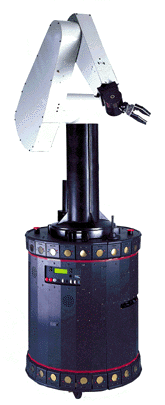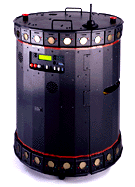|
Features
Revolutionary
holonomic
drive system
Multiprocessor control
system
with MemNETTM
Shared
Memory TCP/IP
network
Advanced power
management
with
integrated battery
charging
User expandable,
distributed
real-time control
network
Full featured software
development
system with real-time
extensions and
fully
functional simulator
Comprehensive sensor
suite
including range,
directional,
and vision
systems
Click on the manipulator to see more
information on XR
Flexible Manipulator
Systems

|
 Overview Overview
The XR4000 is an advanced
mobile robot system that incorporates state of the art drive,
control, networking, power management, sensing, communication and
software development technologies. For serious research in mobile
manipulation, high speed visual servoing, machine learning, and
sensor based navigation the XR4000 offers unparalleled capabilities.
XR Holonomic Drive System
Utilizing advanced
distributed control techniques and a robust modular mechanical
design, the XR drive system (patent pending) is the first holonomic
drive system to offer a full three degrees of freedom (x,y,theta)
without penalties in ground clearance, vibration, or mechanical
complexity. The XR drive system uses four active drive modules
resulting in the coordination of eight independent degrees of
freedom. Encoder feetback from these eight axes provides redundant
information that is filtered to provide improved dead-reckoning
capabilities.
XR MemNET Multi-processor Control
System
The XR MemNET control system is a shared
memory multi-processor system. At the top level a series of Linux-
based Pentium or Pentium Pro (Single or Dual) are networked using
TCP/IP with shared memory as its physical layer. While supporting
standard networking tools, this architecture offers speed of faster
than five times that of standard Ethernet. The shared memory
interface is full duplex, which means that there are no collisions
and data transfer times are 100% deterministic. This allows for
distributed real-time control, something which previously required
expensive VME-based systems. Control of subsystems is accomplished
through a combination of memory mapped slave controllers that reside
on the bus and remote slave controllers that use a real-time token-
passing network to create a shared variable space and standard
Remote Procedure Call (RPC) capabilities. This real-time network is
described in the next section.
XR Synapse Distributed I/O Network
The XR
synapse is a network of distributed controllers linked using the
ARCNET real-time token-passing network. The synapse network creates
a shared variable space and an RPC interface between the controllers
and the high level Pentium/Pentium Pro system. This allows for the
creation of a very high speed virtual shared memory space between
all of the controllers and the Linux systems.
XR Development
System
The XR Development System is a full featured
distributed mobile robot software development system for the XR
series of mobile robots. Its unique distributed architecture uses
the following components: a scheduler that synchronizes simulated
robots across a network, a multi robot simulator, and a graphic user
interface.
XR Helios Power Management System
The XR
power management system provides the Nomad XR mobile robot systems
with comprehensive power diagnostic and control capabilities. This
system allows the robot to be powered directly from AC and also
incorporates a sophisticated two stage fast battery-charging system.
The current going in and out the batteries is integrated, allowing
precise measurement of the charge remaining. Voltage and temperature
are measured for each battery as well as providing safe and accurate
determination of battery damage or end of life. Independent power
control of different subsystems, knowledge of charge remaining, and
the potential for self docking into an AC source allows cognitive
decisions to made by the system regarding task scheduling and other
mission priority issues.
XR Sensors
XR Basic Sensing System
The
Sensus 150TM bi-level tactile system
provides full tactile coverage over the vertical surfaces of the
Nomad XR. In addition to the full overall coverage, 48 bi-level
sensing elements surround the top and bottom perimeters of the Nomad
XR4000 and provide both the exact location of contact as well as a
measure of contact force. Rugged energy absorbing rubber molding
protect the top and bottom perimeters of sensing elements.
The Sensus 250TM three dimensional
sonar system uses 48 sonar transducers precisely positioned at
different levels and angles with coordinated firing patterns to
provide complete coverage from the floor to the Nomad XR's ceiling.
Firing rates, blanking intervals, firing order, and timeouts can be
configured to provide optimal performance in any environment.
The Sensus 350TM infrared system uses
48 transceivers positioned at the top and bottom of the Nomad
XR4000. These sensors provide close-range coverage. The Sensus 350
has a very fast sampling rate, making it very useful for short-range
work.
The Sensus
450TM Monochrome PCI Vision System
The
Sensus 450 is a basic vision system that includes a PCI bus frame
grabber, RS-170 camera, Linux drivers, and image processing
library.
The Sensus
460TM Color PCI Vision System
The Sensus
460 is a basic vision system that includes a color PCI bus frame
grabber, RS-170 camera, Linux drivers, and image processing
library.
The Sensus
550TM Time of Flight Laser Ranging
System
The Sensus 550 system is a high-speed, long-range
sensor that uses the PLS from SICK Electro-Optics to provides up to
360 data points from a 180 degree scan at rates up to 25Hz. Special
interface circuitry allows the Nomad XR to accept the range data at
full rates without burdening the processor with serial port
interrupts.
The Sensus
600TM Digital Compass System
The Sensus
600 is a digital fluxgate compass that has 0.5 degree accuracy in
magnetically clean environments.
Fully integrated software is also included consisting of image
processing routines, development libraries, and drivers that all run
under Linux.
Specifications
Diameter:
62 cm.
Height: 85 cm.
Weight
(Empty): 60 kg.
Weight (With
batteries): 150 kg.
Payload: 100
kg.
Max. Acceleration:
Translational - 5 m/s2
Max.
Acceleration: Rotational - 2
rad/s2
Maximum Translational Speed:-
1.5 m/s
Encoder Resolution:
Base Translation: 1120
counts/cm,
Base Rotation: 422 counts/degree
Caster
Orientation: 76 counts/degree
Number of Wheels:
4
Drive Type: Holonomic
Battery
Capacity: 1575 watt-hour
CPU: Up to 3
Pentium or Pentium Pro
Power System: Fuel gauge,
battery monitoring with onboard charging and full power
diagnostics
[ Top of page
] |

 Overview
Overview